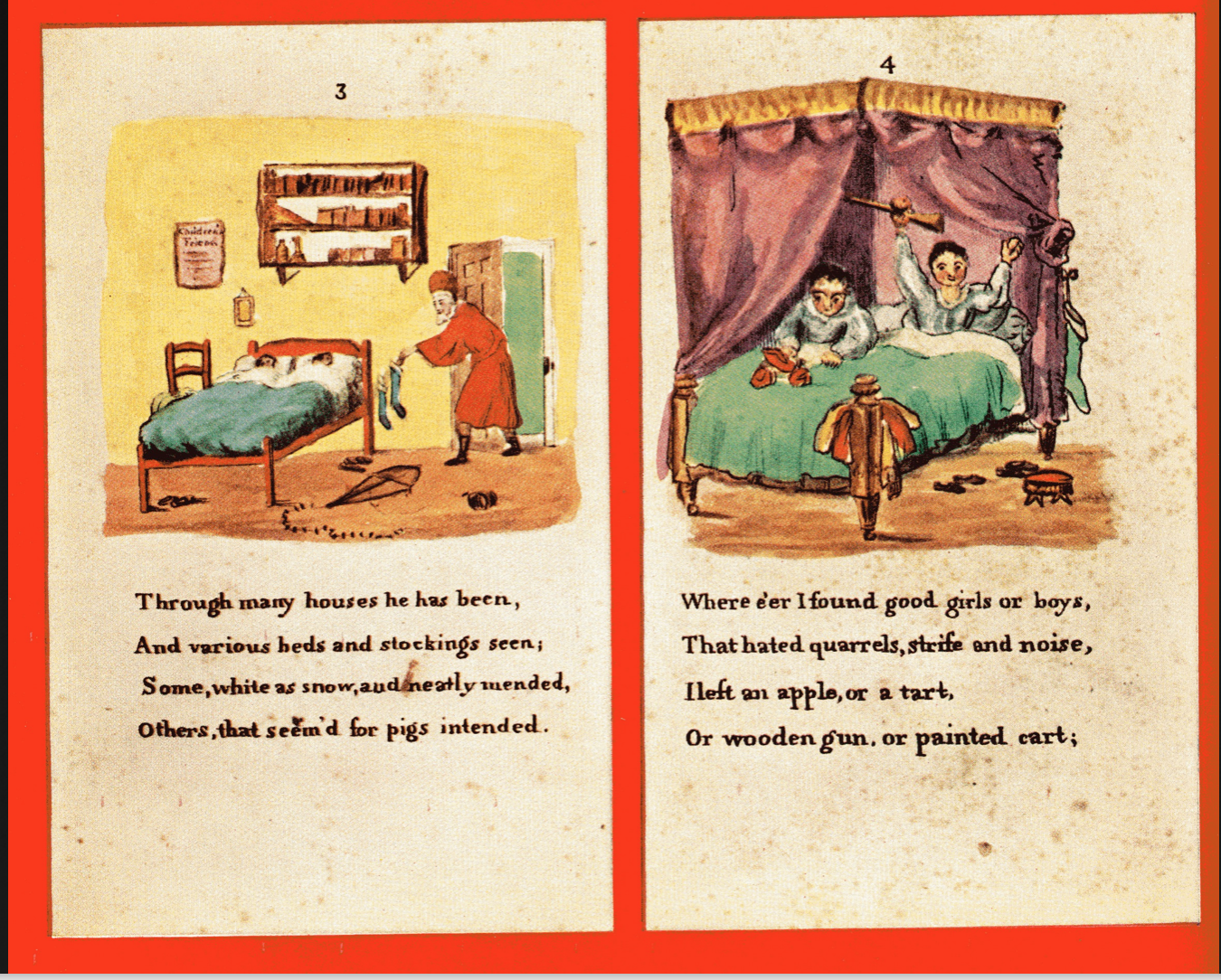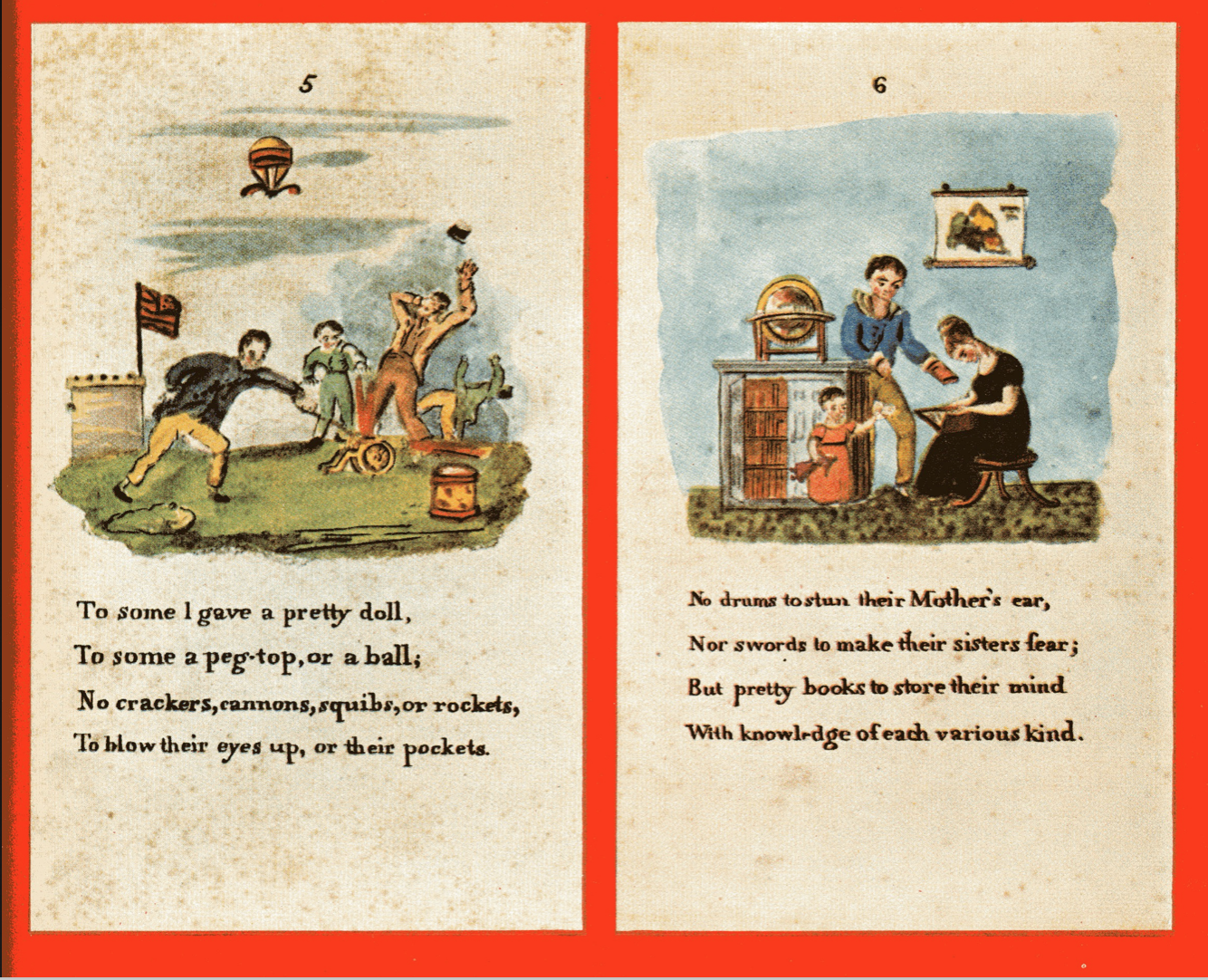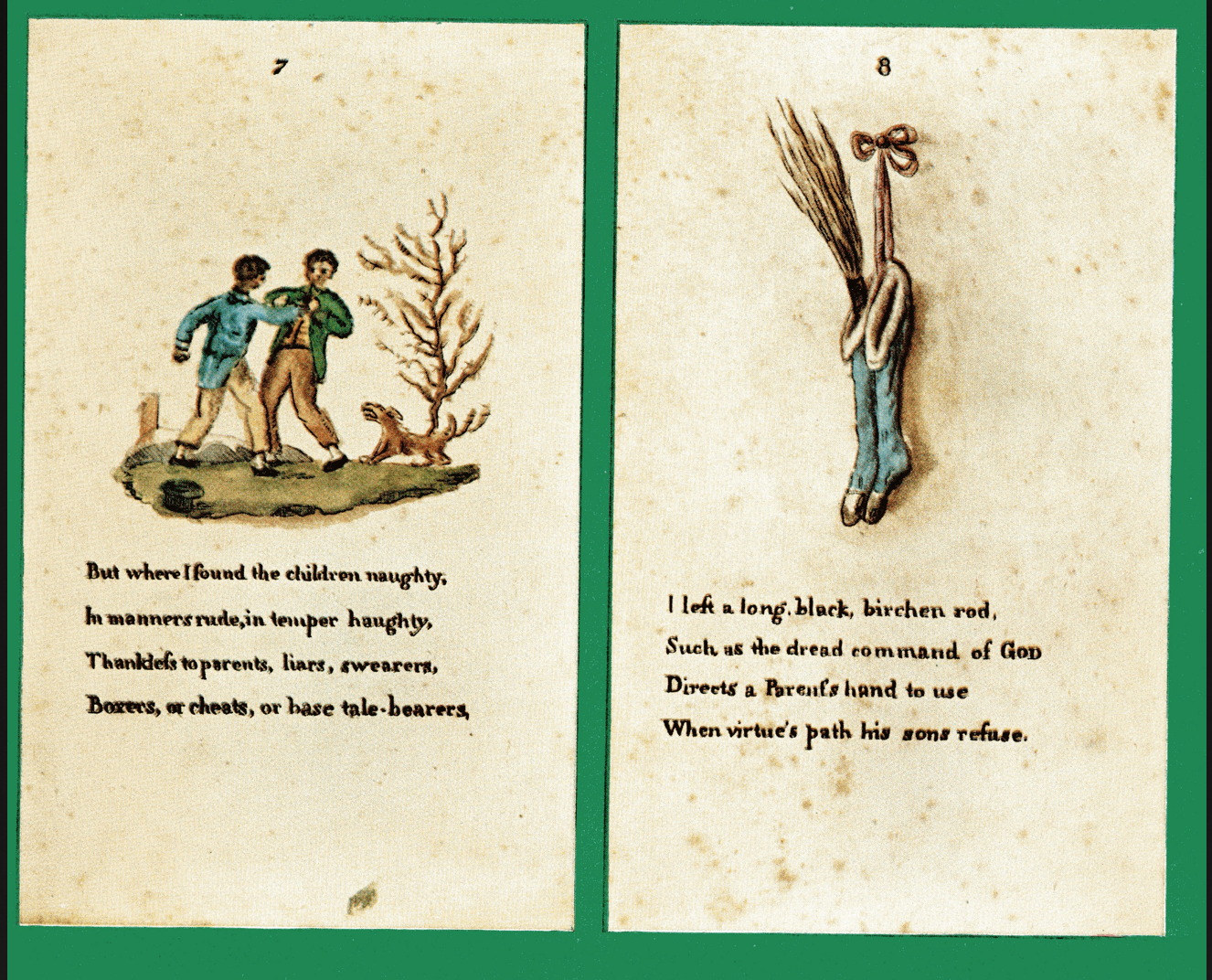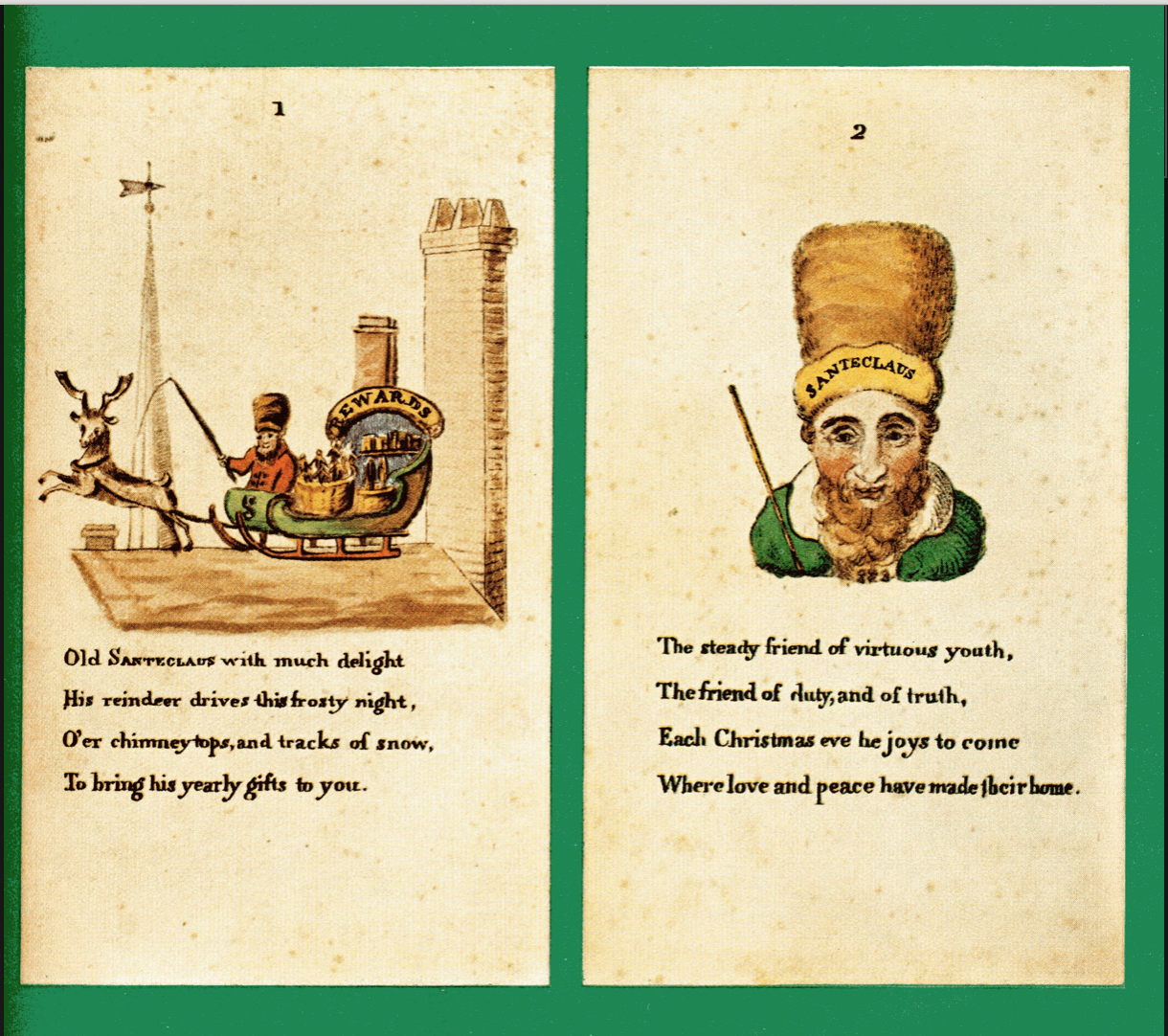From a late-19th-century American humour magazine.
Author: gerryadmin
Christmas 1897 again
This illustration from Life, December 1897, entitled “How He Comes” shows Santa adopting to new technology. As well as being pulled by 12 (!) reindeer, Santa has taken to the new-fangled automobile and telephone lines as means of getting presents to children. He also appears to be employed by the postal service.
Christmas 1897

Christmas
Though doubters doubt and scoffers scoff,
And peace on earth seems still far off
Though learned doctors think they know
The gospel stories are not so;
Though greedy man is greedy still
And competition chokes goodwill,
While rich men sigh and poor men fret,
Dear me! we can’t spare Christmas yet!
Time may do better–maybe not ;
Meanwhile let’s keep the day we’ve got!
On Bethlehem’s birth and Bethlehem’s star
Whate’er our speculations are,
Where’er for us may run the line
Where human merges with divine,
We’re dull indeed if we can’t see
What Christmas feelings ought to be,
And dull again if we can doubt It’s worth our while to bring them out.
“Glory to God: goodwill to men !”
Come! Feel it, show it, give it, then!
Come to us, Christmas, good old day,
Soften us, cheer us, say your say
To hearts which thrift, too eager, keeps In bonds, while fellow-feeling sleeps.
Good Christmas, whom our children love,
We love you, too! Lift us above
Our cares, our fears, our small desires!
Open our hands and stir the fires
Of helpful fellowship within us,
And back to love and kindness win us!
– E. S. Martin., Life, 1897
A Children’s Friend 3
A Children’s Friend 2
What on earth possessed the unknown author to portray Santeclaus in a reindeer sleigh? St Nicholas had always come on a flying horse or wagon, the Christ Child and assorted European gift-bringers always walked, sometimes with a scary helper, sometimes with a donkey.
The reindeer, sleigh, and fur clothes indicate someone from a northerly clime — no one had ever thought that was a necessary attribute before — but it leads straight to a sleigh pulled by 8 reindeer, a setting in the North Pole, and an army of industrious elves
A Children’s Friend
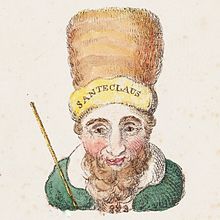 In 1821 an anonymous poet took his own peculiar version of the name Sinterklaas, and wrote the word “Santeclaus” on the fur hat of a revolutionary new character. This new gift-bringer was not the Dutch bishop, or frightening dark figure, or the Baby Jesus; he was an elderly man in a fur robe, arriving on roof tops in a sleigh pulled by a reindeer.
In 1821 an anonymous poet took his own peculiar version of the name Sinterklaas, and wrote the word “Santeclaus” on the fur hat of a revolutionary new character. This new gift-bringer was not the Dutch bishop, or frightening dark figure, or the Baby Jesus; he was an elderly man in a fur robe, arriving on roof tops in a sleigh pulled by a reindeer.
It is impossible to overstate the importance of this poem, The Children’s Friend: A New Year’s Present, to Little Ones from Five to Twelve published by William Gilley. It included eight illustrative plates (hand-coloured upon additional payment) and eight verses about the American gift-bringer’s activities. It gave the world a secular gift-bringer, someone who could be embrace by children of any denomination or ethnic background. It made him a creature of the North — clad in fur and reindeer-powered. It definitively moved gift-bringing to Christ Eve, casting St Nicholas’ Day and New Year’s Eve into disrepute. From this date forward the man we know as Santa Claus accelerates into our culture.
Over the next few days we will explore this too-little-known masterpiece.
The Invention of Santa Claus

Before 1821 there were a number of Christmas gift-bringers in the USA. Dutch families, chiefly in New York, honoured Sinterklaas, their name for St Nicholas. Since no American had written about Sinterklaas, his legend spread orally and a variety of spellings referred to Santa-claw, St a. Klaus, Sandy Claw, Sancte Claus, etc. In Pennsylvania and Maryland, German immigrants had brought Belsnickle (or Pelznichol), a rough fur-clad fellow, or Kriss Kringle (or Kriss Krinkle or Krishkinkle, etc.), their version of das Christkindl or Christ Child. Some English immigrants referred to Queen Mab or other fairies but as yet, there was no Santa Claus.
This poem entitled will show how ethnically particular the St Nicholas figure was by 1810. He comes on his saint’s day (December 6), not on Christmas Eve, and his presents are clearly Dutch, especially the giant cookies in the shape of the bishop.
Oh good holy man! whom we Sancte Claus name,
The Nursery forever your praise shall proclaim;
The day of your joyful revisit returns,
When each little bosom with gratitude burns,
For the gifts which at night you so kindly impart
To the girls of your love, and the boys of your heart.
O! Come with your panniers and pockets well stow’d,
Our stockings shall help you to lighten your load,
As close by the fireside gaily they swing
While delighted we dream of the presents you bring.
Oh! Bring the bright Orange so juicy and sweet,
Bring almonds and raisins to heighten the treat;
Rich waffles and dough-nuts must not be forgot,
Nor Crullers and Oley-Cooks [cookies] fresh from the pot.
But of all these fine presents your Saintship can find,
O! Leave not the famous big Cookies behind;
Or, if in your hurry, one thing you mislay,
Let it be the Rod – and ah! keep it away.
Then holy St. Nicholas! all the long year,
Our books we will love, and our parents revere;
From naughty behavior we’ll always refrain,
In hopes that you’ll come and reward us again.
Good News

“Good News” is a nineteenth-century African American Christmas song in which the birth of Jesus is the good news which produces salvation regardless of race. Here are the lyrics as printed in Honey in the Rock: The Ruby Pickens Tartt Collection of Religious Folk Songs.
God knows I am a Christian
Knows I ain’t ashame
De Holy Ghost is my witness
An’ de angel done sign my name.
Chorus : Wa’n’t that good news, good news
Angel brought tidin’s down
Good news, good news
I’m huntin’ fer de Lord.
Oh, one dark night in December
Christ our Savior was born.
De bright light shine from heaven
Down by Bethlehem’s stable door.
Oh, you may be a white man
White as de dribberlin’ snow
Ef yo’ soul ain’t ankeld in Jesus
To hell you showly go.
Oh. “H” stands fer old hell
You may go dere ef you please
Search old hell wid a fine-tooth comb
You won’ find na’y Christian dere.
Christmas Wishes from the Chinese Army
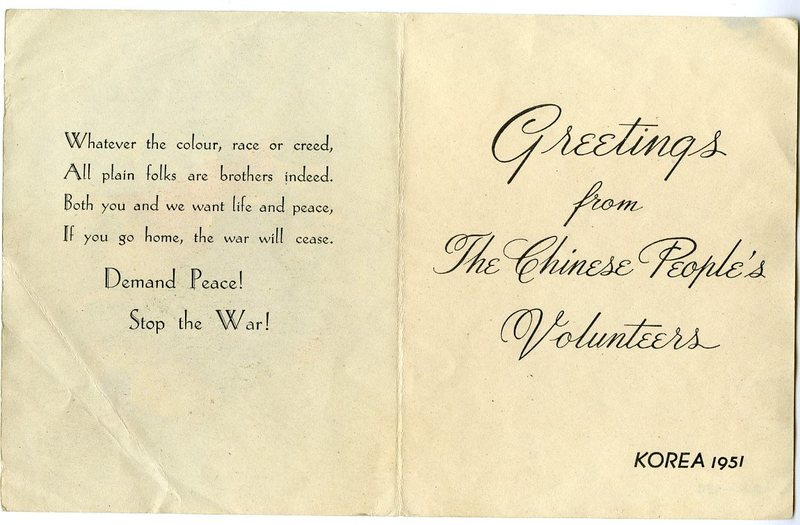
In the 20th century it was common for armies to use Christmas as a propaganda tool against their enemies. In January we posted a Russian leaflet using the holiday to lure German soldiers into surrendering. Germans used similar appeals to weaken the morale of American troops.
During the Korean War, the “volunteer” army of Communist Chinese troops sent Christmas greetings to Allied forces (mostly American) opposing them. The text reads:
We are wishing you a Merry Christmas and a Happy New Year. We also have something to talk to you about.
Christmas is a day of peace and happiness. And a day for family reunions.
But this Christmas, for you, there is no peace. You are far away from those you love, in Korea, a country you never heard of three years ago–hundreds of thousands of casualties ago. Your family longs for you across the wide pacific. Will they ever see you again? Will you ever see them again?
You’ve been told you came here to stop “Communist Aggression.” But what do your own eyes and head tell you? The Koreans are fighting in their own country. The Chinese are defending their own nearby borders. Neither of these people ever dreamed of invading the United States. It is U. S. Troops who have come here with bombs, napalm, +++ and other weapon of mass murder.
Bombs and guns can’t break the spirit of the Koreans and Chinese because they are guarding their homes. What about you? Is there any reason why you should be here instead of home with your folks? You are risking death or crippling wounds to hold on to one or two bare Korean mountains. What for?
The heartless men who sent you here have sent American soldiers to Europe. These soldiers too are told that they must protect different countries from “Red Aggression.” But everywhere they go they hear the people yelling, “Yanks, go home.” This wasn’t the way GI’s were greeted everywhere in world War II when they were really fighting agains aggressors–the Nazis and Japanese warlords. Then they got flowers. So something is wrong. What is it?
The truth is that American soldiers today are helping oppressors, not fighting them. You know how the Koreans “love” Syngman Rhee! You know how the Chinese “loved” Chaing Kai-shek whom they kicked out in spite of $6 billion worth of U. S. aid. In Japan the U. S. is letting convicted war criminals out of jail and giving them a new army to play with. In Germany, it’s the same. In France, in Italy, they back governments which have sold out their own peoples for dollars, governments which order the police out every time working people strike for a living wage. Isn’t this true? You know it is.
Why are Americans sent abroad to do this kind of dirty work, the exact opposite of every fine thing America ever stood for, in a way that would make Washington, Jefferson, Lincoln turn over in their graves if they knew it? Because the American government has been stolen from the American people by greedy Big Business which cares nothing about your life or anyone else’s but only for its lousy profits. The corporations have made more money since the Korean war than they ever did before, out of arms orders for which the American people are paying through higher taxes, higher prices in every grocery store and the lives of their sons–YOUR lives. That’s why the Brass Hats are throwing monkey wrenches into the talks at Panmunjom which could have succeeded a year ago. That’s why they want more war everywhere, not peace.
Every people on earth is getting wise to this new kind of business–Murder for Profit. Americans at home are getting wise to it too. Millions are asking for peace and getting fed up iwht the lies. American fathers and mothers have refused medals sent to them after their boys died in Korea. Hundreds of American pilots with decorations for courage in World War II have refused to fly in Korea. Tens of thousands of young men are dodging the draft. This is not because they are cowards. It is not because they aretn’t ptriotic. It’s because they are beginning to understand that they’ve been fooled.
The patriotic thing is to fight for peace! The patriotic thing is to fight for friendship, not war, between peoples! What harm can peace do to any country, to America? What good does war bring to any nation, Americans included? The real traitors, the real criminals, are the few who send troops, thousands of miles away so they can rake in dollars. They think they own America, and for that matter the world. They think they own you. Who gave them the right? What kind of free American citizen are you when they can shove you into uniform, pack you in a boat, and send yo to all end of the earth for no reason than this?
We the Chinese People’s Volunteers, are writing you this letter, We came here because, after we cleaned out the dirty grafter Chaing Kai-shek, you stormed into the land of our neighbor and threatened the first chance we ever had to build up our country. We don’t want to fight anyone. We want to build in peace. We are in favor of peaceful coexistence and trade for every people in the world.
Don’t believe the Big Money boys and politicians at home. They are no different from Chaing Kai-shek whom we ran out of China. Don’t do what they want. Do what the people want.
We offer you peace and friendship. America for Americans. Korea for the Koreans. China for the Chinese. Why should not we all, Korean soldiers, Chinese soldiers, American soldiers join our efforts for peace? Then we don’t need to be soldiers any more. Then next Christmas, if not this one, can really be merry. Then we can have a really Happy New Year in 1953! Let’s make it so!
—The Chinese People’s Volunteers
Christmas Bummers

One does not expect the word “bum” to be associated with Christmas, but here we are. First a lexicographic discussion of the term. In Britain and the Commonwealth bum refers to one’s bottom; one sits on one’s bum. Thus in Australia a “Christmas bummer” is underwear decorated with pictures of Santa or reindeer or candy canes.
In the United States, however, bum refers to a hobo or mendicant. To bum around is to wander as a vagrant; to bum is to beg. Throughout the nineteenth-century, American churches differed as to celebrating Christmas. The feast was fully supported by Catholics, Lutherans, Episcopalians, and northern Methodists; it was opposed by Baptists, Quakers, southern Methodists, and a host of independent sects. As the years went by, more and more denominations succumbed to the lure of Christmas. Many churches began to eye Santa Claus as a figure of tremendous appeal who could attract children (and thus their parents) to Christian worship. Churches, particularly those involved in missions to the urban poor, began to compete with each other in the mounting of December pageants and ceremonies of gift-giving. The Pilgrim Unitarian Church in San Francisco hired a public hall and featured songs, recitations and tableaux, a giant Christmas tree hung with lights and presents, artificial snow falling from the ceiling, and a Santa driven into the room in a sleigh drawn by two real deer. Even on the sparsely settled prairie, Christmas productions were deemed indispensable. In December 1886 churchgoers in Sioux Falls, South Dakota, could choose from the Congregationalists’ “Santa Clausville,” the Baptists’ literary musical entertainment and supper, the Presbyterians’ “Gathering of the Nations to Meet Santa Claus,” or the Methodist-Episcopal “Christmas House” with Santa. The latter, a playlet by Edward Eggleton, was a popular one in churches and is noteworthy for the character of Santa Claus condemning “Christmas bummers”—children who only made an appearance in Sunday School at Christmas and who often went from one church to another to gather yet more loot in the spirit of Halloween.
In the twenty-first century “Christmas bummer” has come to refer to an aspect of the holiday that makes one depressed. Sad Christmas songs such as “Christmas Eve Can Kill You” by the Everley Brothers, “Santa Can’t Stay” by Dwight Yoakam, or Joni Mitchell’s “River” are guaranteed to provoke tears.


